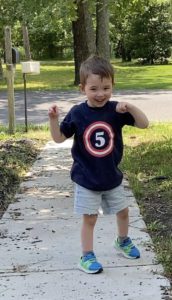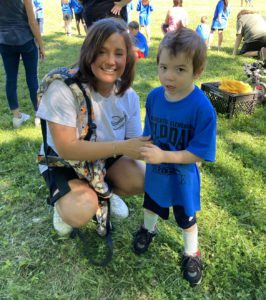Before you read on, don’t forget to check out Part 1 of our interview. In Part 1, Alex discusses the multi-year diagnostic odyssey to discover that Raymond has VAMP2. Today, we talk about what VAMP2 is, research into this condition, launching a foundation, and how Raymond is doing today.
What is VAMP2?
The Congenica information shared on Alex’s website explains that Vesicle Associated Membrane Protein 2 (VAMP2) is located on the p arm of human chromosome 17, and has an autosomal dominant mode of inheritance. It further explains that VAMP2 is a:
neurodevelopmental disorder with hypotonia and autistic features with or without hyperkinetic movements.
But given that the first case of VAMP2 was diagnosed in Ohio in 2018, it’s clear that the understanding of this disorder is still in its early stages. As Alex shares:
VAMP2 is a complicated diagnosis. There are now 18 different variants – within 20 cases around the world – and only two cases have the same variant. Even two years into the diagnosis, it’s hard to explain. A few researchers that I’ve been in contact with have said that research is still in its early stages. At this point, VAMP2 is so rare that we don’t know the impact.
Symptoms or characteristics which seem, so far, to be associated with VAMP2 include learning and cognitive disabilities, neurodevelopmental delays, and epilepsy.
Coming to Terms with a Rare Disease Diagnosis
Alex explains that the years leading up to Raymond’s diagnosis were some of the most challenging years of her entire life. Those years taught her forgiveness, love, patience, and sacrifice. That life can be hard and doesn’t always turn out the way that you expect. But because of that, Alex says, she has also become the person she is today: a strong, passionate advocate and mother who wants to make the world a better place. She has overcome situations that many people could not comprehend and gained knowledge in areas that she may otherwise have not been interested in.

Alex shares:
I want to be the voice of the parents who can’t speak. It beats me up every day watching Raymond struggle. I don’t want to just make a change for VAMP2, but for everyone with a rare disease. A diagnosis doesn’t define you or your family. There are so many diagnoses in the world that people hear and immediately picture an image in their heads. That needs to stop. Everyone’s journey is different. There are similarities but no one person will have the same experiences. Most of this world is intimidated by the word rare which I can agree is quite scary, but it is only rare until awareness is raised and we work toward cures. I am determined to take away the scariness of the word rare.
Part of making this change is working to create a community and garner support. In 2020, Alex became one of the two parents on the administration team of the worldwide VAMP2Facebook page. She plays a role in connecting families affected by VAMP2; they stretch from Australia, Serbia, and Spain to Ireland, the UK, Italy, and the United States.
Alex also launched her website to help raise awareness of VAMP2 on a greater scale. She hopes that this will help educate doctors and provide a great learning process for others.
VAMP2 Research
Shortly after launching her website, Alex was contacted by a neurologist in London who is in the beginning stages of working on a cure for VAMP2. Alex shares:
In 2023, I will be putting together a Patient Collection Database with VAMP2 cases for the neurologist and genetics expert that they can use for their research. I recently began a spreadsheet and am adding questions that I feel are beneficial to researchers. These include variants, epilepsy, allergic reactions to medication, how children have progressed and whether they complete tasks appropriately, independent walking and crawling. Ultimately, I hope that this can help advance research.
Outside of London, the Children’s Medical Research Institute in Sydney, Australia is also working on a gene therapy study. So far, Raymond, as well as a child in Australia with VAMP2, have donated blood samples to the lab. Alex is currently working with other families and their physicians to provide as many blood samples to the study as possible. Says Alex:
The biggest issue right now is funding. It could take anywhere from 5-15 years depending on trial phases and funding. They haven’t gotten a mouse model yet, but it is in the works. We do an annual fundraiser for our hospital and have raised $6,500, and are hoping to soon launch an annual fundraising event for VAMP2.
Raging Raymond Foundation, Inc.
In 2023, Alex is planning on returning to school to obtain a degree in the healthcare field. Her long-term goal is to become a doctor, but she’s interested in medical coding and billing as she feels that is a field that directly impacts patients. She is also interested in eventually getting involved in genetics, a topic that has become increasingly more interested in following Raymond’s diagnosis. Outside of these plans, Alex also hopes to get involved in this field by launching the Raging Raymond Foundation, a 501(c)(3) nonprofit which will help fund the current research being done. Through the Foundation, families would also be able to receive funds for essential equipment, medication, and other needs.
Raymond Today
In 2021, Raymond began walking independently, as well as vocalizing new sounds. His family was thrilled as they watched improving hand coordination, and as Raymond became increasingly interested in playing with new toys, learning about books, and spending time with his siblings and peers at school.

Since then, his improvement has only continued. Alex shares:
Raymond is so laid-back. He’s doing really well. For the last two months, he has been off seizure medication. He’s started trying to get into and out of bed on his own using his therapy steps. Our biggest struggle is communication. He got his AAC device in September and is starting to isolate his pointer finger to point to what he wants. There’s a lot of nonverbal communication but we can see his excitement about communicating better. Honestly, he’s a really happy kid and I’m so grateful for that. But seeing other families struggle more than us only gives me more motivation to work towards a cure. I want to make sure that nobody else has to fight for as long as we’ve had to.
No matter what comes next, Alex remains hopeful for the future of children with VAMP2. Although families face different challenges, Alex is so grateful for the support through the highs and lows of the disorder – and knows that her son’s smile will always brighten her day.


